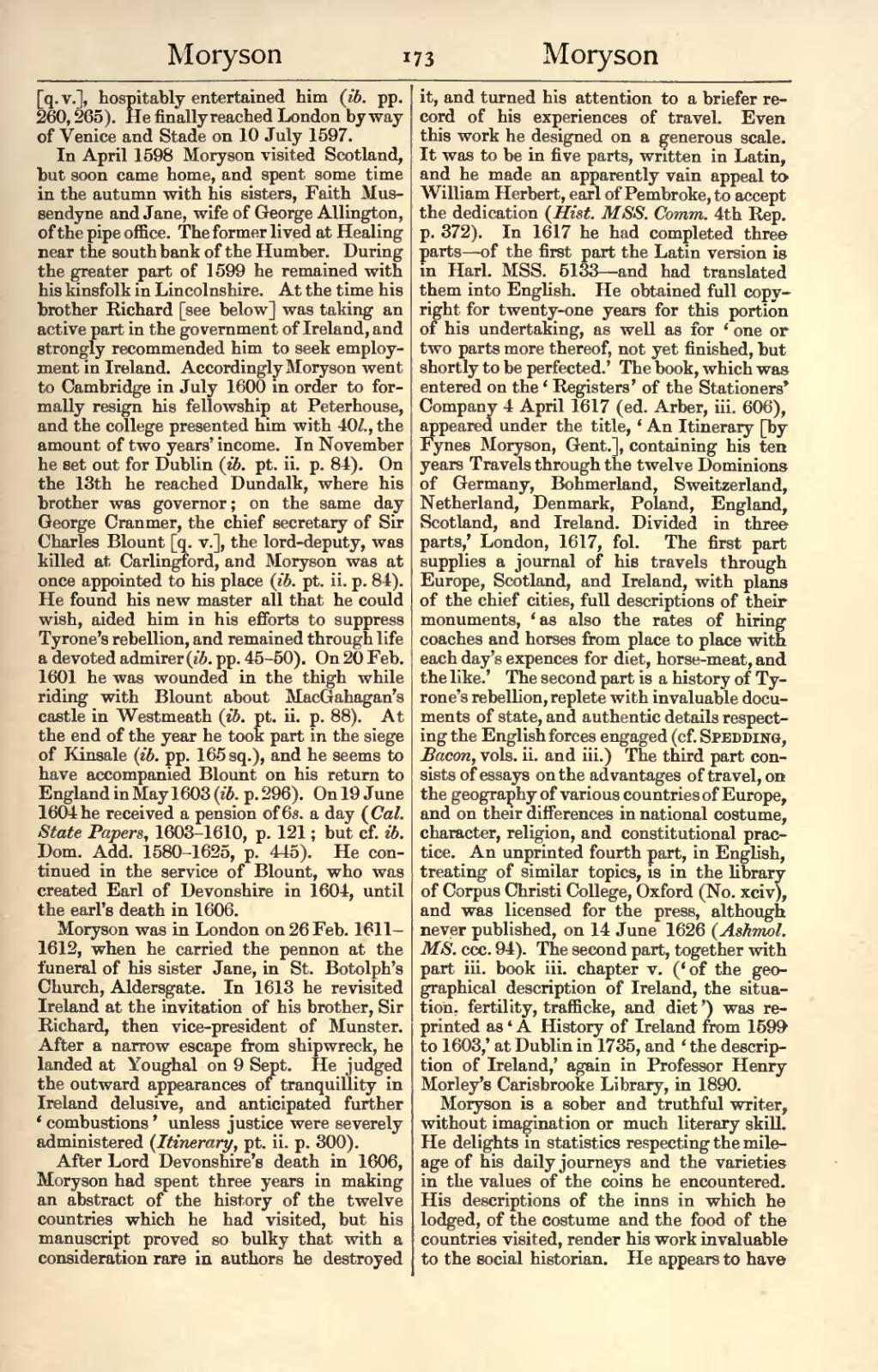[q. v.], hospitably entertained him (ib. pp. 260, 265). He finally reached London by way of Venice and Stade on 10 July 1597.
In April 1598 Moryson visited Scotland, but soon came home, and spent some time in the autumn with his sisters, Faith Mussendyne and Jane, wife of George Allington, of the pipe office. The former lived at Healing near the south bank of the Humber. During the greater part of 1599 he remained with his kinsfolk in Lincolnshire. At the time his brother Richard [see below] was taking an active part in the government of Ireland, and strongly recommended him to seek employment in Ireland. Accordingly Moryson went to Cambridge in July 1600 in order to formally resign his fellowship at Peterhouse, and the college presented him with 40l., the amount of two years' income. In November he set out for Dublin (ib. pt. ii. p. 84). On the 13th he reached Dundalk, where his brother was governor; on the same day George Cranmer, the chief secretary of Sir Charles Blount [q. v.], the lord-deputy, was killed at Carlingford, and Moryson was at once appointed to his place (ib. pt. ii. p. 84). He found his new master all that he could wish, aided him in his efforts to suppress Tyrone's rebellion, and remained through life a devoted admirer (ib. pp. 45–50). On 20 Feb. 1601 he was wounded in the thigh while riding with Blount about MacGahagan's castle in Westmeath (ib. pt. ii. p. 88). At the end of the year he took part in the siege of Kinsale (ib. pp. 165 sq.), and he seems to have accompanied Blount on his return to England in May 1603 (ib. p. 296). On 19 June 1604 he received a pension of 6s. a day (Cal. State Papers, 1603–1610, p. 121; but cf. ib. Dom. Add. 1580–1625, p. 445). He continued in the service of Blount, who was created Earl of Devonshire in 1604, until the earl's death in 1606.
Moryson was in London on 26 Feb. 1611–1612, when he carried the pennon at the funeral of his sister Jane, in St. Botolph's Church, Aldersgate. In 1613 he revisited Ireland at the invitation of his brother, Sir Richard, then vice-president of Munster. After a narrow escape from shipwreck, he landed at Youghal on 9 Sept. He judged the outward appearances of tranquillity in Ireland delusive, and anticipated further ‘combustions’ unless justice were severely administered (Itinerary, pt. ii. p. 300).
After Lord Devonshire's death in 1606, Moryson had spent three years in making an abstract of the history of the twelve countries which he had visited, but his manuscript proved so bulky that with a consideration rare in authors he destroyed it, and turned his attention to a briefer record of his experiences of travel. Even this work he designed on a generous scale. It was to be in five parts, written in Latin, and he made an apparently vain appeal to William Herbert, earl of Pembroke, to accept the dedication (Hist. MSS. Comm. 4th Rep. p. 372). In 1617 he had completed three parts—of the first part the Latin version is in Harl. MSS. 5133—and had translated them into English. He obtained full copyright for twenty-one years for this portion of his undertaking, as well as for ‘one or two parts more thereof, not yet finished, but shortly to be perfected.’ The book, which was entered on the ‘Registers’ of the Stationers' Company 4 April 1617 (ed. Arber, iii. 606), appeared under the title, ‘An Itinerary [by Fynes Moryson, Gent.], containing his ten years Travels through the twelve Dominions of Germany, Bohmerland, Sweitzerland, Netherland, Denmark, Poland, England, Scotland, and Ireland. Divided in three parts,’ London, 1617, fol. The first part supplies a journal of his travels through Europe, Scotland, and Ireland, with plans of the chief cities, ‘the rates of hiring coaches and horses from place to place with each day's expences for diet, horse-meat, and the like.’ The second part is a valuable history of Tyrone's rebellion, with documents of state (cf. Spedding, Bacon, vols. ii. and iii.). The third part consists of essays on travel, geography, and national costume, character, religion, and constitutional practice. A manuscript fourth part, in English, treating of similar topics, is in the library of Corpus Christi College, Oxford (No. xciv), and was licensed for the press, though not then published, on 14 June 1626 (Ashmol. MS. ccc. 94). The second part, together with part iii. book iii. chapter v. (‘of the geographical description of Ireland, the situation, fertility, trafficke, and diet’) was reprinted as ‘A History of Ireland from 1599 to 1603,’ at Dublin in 1735, and ‘the description of Ireland,’ again in Professor Henry-Morley's Carisbrooke Library, in 1890.
Moryson is a sober and truthful writer, without imagination or much literary skill. He delights in statistics respecting the mileage of his daily journeys and the varieties in the values of the coins he encountered. His descriptions of the inns in which he lodged, of the costume and the food of the countries visited, render his work invaluable to the social historian. He appears to have
